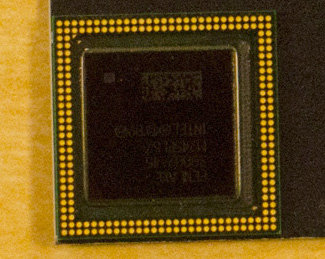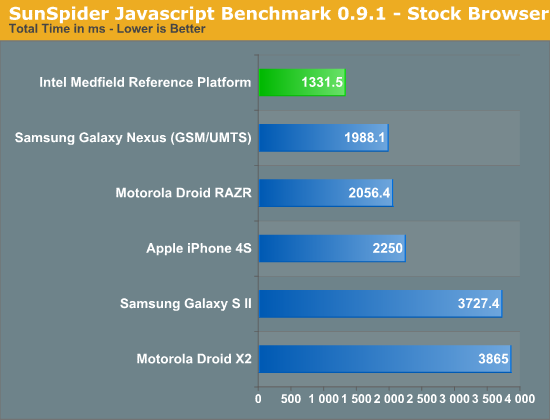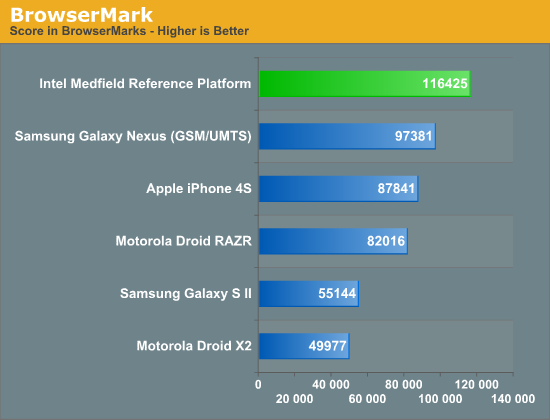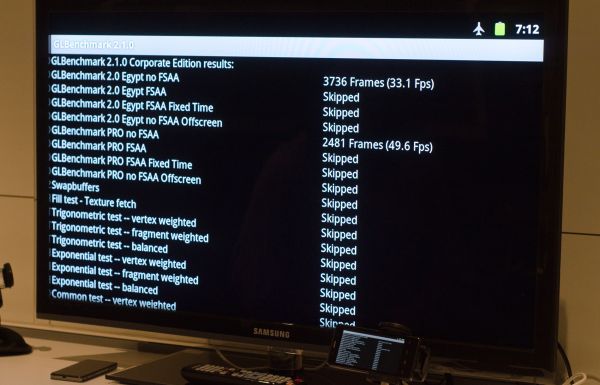Intel's Medfield & Atom Z2460 Arrive for Smartphones: It's Finally Here
by Anand Lal Shimpi on January 10, 2012 8:00 PM ESTIt's here. Intel's first smartphone SoC that you'll actually be able to buy in a device before the end of the year. The platform is called Medfield and Paul Otellini just announced its first device partners.
Medfield starts out as a bonafide mobile SoC. Whereas Moorestown was a "two-chip" solution, Medfield is just one - the Penwell SoC:

The SoC is only available in a PoP (Package on Package) configuration measuring 12mm x 12mm. Intel wouldn't give out a die size but it did show me a Penwell sample without the stacked DRAM:

Since I know the measurements of the package I could estimate the dimensions of the silicon itself. My math worked out to be around 62mm^2. That's larger than a Tegra 2-class SoC, but smaller than Tegra 3 or Apple's A5. The diagram of its high level architecture above helps explain why.
There's only a single version of Medfield being announced today: the Intel Atom Z2460. The Z2460 features a single Atom core with a 512KB L2 cache, a PowerVR SGX 540 GPU and a dual-channel LPDDR2 memory interface. In a world where talking about four Cortex A9s and PowerVR SGX 544MP2s isn't uncommon, Medfield starts out almost sounding a bit...tame. But then you see its performance:

Although running what appears to be a stock Gingerbread browser, Intel's Medfield reference platform posts SunSpider performance better than any other smartphone we've tested - including the Galaxy Nexus running Ice Cream Sandwich. Intel promises that Medfield's performance will scale on ICS as well - the gap should be maintained. We've seen high results from reference designs in the past, but the Medfield platform is a little different as you'll soon see - it's a complete smartphone design that should be representative of handsets that hit the market later this year.
Medfield isn't a one trick pony either, performance is similarly dominating under BrowserMark:

These are tablet-like scores. Here the Galaxy Nexus running ICS comes close, but once again Intel expects that on the same OS Medfield should be faster than any of the currently available SoCs.
I asked Intel where its SunSpider and BrowserMark performance advantages came from, especially considering we've typically only seen huge gains with new browsers and not new SoCs. Their response pointed to a bunch of factors, but one stand out issue was the A9 has a great execution core but seems to be more limited on the memory interface. Atom can support far more outstanding misses in L2 than the Cortex A9, which chokes bandwidth to the processor for anything not already in the L2 cache. This may be one of the reasons why we've never been able to get really high bandwidth numbers out of A9 based SoCs. It's probably safe to assume that things will be different with the Cortex A15, but for now it's little things like this that give Medfield a performance advantage.
GPU performance is understandably not as impressive. We couldn't get offscreen numbers of GLBenchmark 2.1 but we did get results at the device's native resolution (1024 x 600):
3D performance is better than the OMAP 4460 due to Medfield's 400MHz GPU clock compared to ~300MHz in most OMAP4 devices.
Performance without power considerations is meaningless, especially in the smartphone world. Luckily for Intel, Medfield seems very competitive there as well. Intel provided some power and performance data for Medfield based on its reference platform. I still haven't been able to verify any of this for myself, but I was able to see some power tests run in person on the reference platform and competitive devices.
The Intel provided values are pretty astonishing . Sub 20mW idle, sub 750mW during a call on 3G and although not pictured here, Intel's internal data suggests ~1W power consumption while browsing the web compared to ~1.3W on the iPhone 4S and Galaxy S 2. I've done my own measurements on 4S web browsing and came up with a very similar value.
| Intel Measured Smartphone Power Consumption (Identical Display Brightness) | ||||||
| Standby (3G) | Talk (3G) | Browsing (3G) | Video Playback 720p | |||
| Apple iPhone 4S | ~38mW | ~800mW | ~1.3W | ~500mW | ||
| Intel Medfield Reference | ~18mW | ~700mW | ~1.0W | ~850mW | ||
| Samsung Galaxy S II | ~19mW | ~675mW | ~1.2W | ~650mW | ||
The performance and power data both look great for Medfield. You would think that this data, assuming there's nothing fundamentally wrong, would be enough to convince a handset maker to actually give Intel a shot. You'd be right.
In addition to disclosing Medfield performance data, Intel is also announcing partnerships with both Motorola and Lenovo. The former is a broad, multi-year agreement stating that Motorola plans on creating many devices based on Intel silicon - the first of which will be a smartphone due out before the end of the year. Tablets will follow at some point as well.
Lenovo on the other hand will actually be taking and tweaking Intel's own Medfield reference platform, and releasing it in China in Q2.
All of this is exactly what Intel needed: a start.











164 Comments
View All Comments
BSMonitor - Wednesday, January 11, 2012 - link
Lot of "if's" and "shoulds" in your argument.Lucian Armasu - Wednesday, January 11, 2012 - link
Well, he's comparing Atom with ARM based on benchmarks that Intel has provided, and for a chip that won't be out until the end of the year. So that's not very realistic either. Intel has been saying for a long time that "this is finally the year we're going to compete with ARM". I'm very skeptical at this point, until I really see it in the market, in a real phone, and see how it does against the competition then.tipoo - Thursday, January 12, 2012 - link
Indeed, we'll have to wait and see. Also, since this chip is a single core its easier to get its full potential, on apps that are well threaded we might see even current ARM chips beat it.Donnie Darko - Wednesday, January 11, 2012 - link
I'm generally more excited to see x86 in the market because it will drive competition more than it will drive Intel into a new field.It was an impressive technology demo, but to be honest untill they can integrate the base band radio onto the SOC they won't compete. You will be able to buy their phones and that's nice, but Qualcom will still dominate the market with Sammy/Ti and even Nvidia (shudder) rounding out most of the other designs.
Having a top to bottom stack will be nice though for everyone. Arm laptops/tablets, file servers, massivly-wide simple-instruction servers and phones. x86 HP computing (Sever->Tablets) and phones. If Intel can make enough of a beac h head then we should see AMD in the mobile space in a couple of years two. Their synthesisable CPU cores with Bobcat and their GPUs would be wicked down there.
guilmon19 - Wednesday, January 11, 2012 - link
I usually like competition as well, but when intel jumps in there i (shudder). At the moment Samsung, Motorla, qualcom, texas, ect were competing with each other with their own SoC, but they had to use the same fab to build their CPU's, but intel has their own fab(that is alot better then the ones used to build ARM) so they get a huge advantage over all those companies.Griswold - Wednesday, January 11, 2012 - link
It's the answer to a question nobody asked!tipoo - Thursday, January 12, 2012 - link
And to the left of it! Its the comment that means no one but the original poster, if even that!pugster - Wednesday, January 11, 2012 - link
Frankly, I don't know how does Intel can do 1.6ghz cpu and 400mhz gpu for less power than an arm cpu. Gees, we have seen 1.6ghz atom cpus in netbooks and the power envelope is much higher and a 32nm process can't reduce this much further.Second, the phone's cpu is usually in deep sleep most of the time, intel didn't really benchmark what happens when the phone is idle, IE standby time.
Third, is cost. Unless Intel start selling these cpus at giveaway prices for less than $15, I doubt that these phones are competitive to ARM variants.
Fourth is adoption rate. Considering that most of the apps are written for the ARM cpus, I wonder when phone manufacturers and porogrammers will port intel version of their apps.
bobsmith1492 - Thursday, January 12, 2012 - link
The article covers power consumption and porting.Cost is a valid concern! Real-life use cycles will be good to show how quick it transitions into and out of sleep for real-life power use. Being faster when active with the same power use though it should be better if anything. The clock rate scaling will compete against the big-little architecture for ARM, too.
Roy2001 - Wednesday, January 11, 2012 - link
Very impressive. Good job Intel!